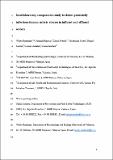Por favor, use este identificador para citar o enlazar a este item:
http://hdl.handle.net/10261/183968COMPARTIR / EXPORTAR:
 SHARE SHARE
 CORE
BASE CORE
BASE
|
|
| Visualizar otros formatos: MARC | Dublin Core | RDF | ORE | MODS | METS | DIDL | DATACITE | |

| Título: | Interlaboratory Comparative Study to Detect Potentially Infectious Human Enteric Viruses in Influent and Effluent Waters |
Autor: | Randazzo, Walter CSIC ORCID; Piqueras, Joaquín; Evtoski, Zoran CSIC ORCID; Sastre, Guadalupe; Sancho, Raquel; Gonzalez, Carina; Sánchez Moragas, Gloria CSIC ORCID | Palabras clave: | Foodborne viruses Viability RT-qPCR Sewage Effluent water |
Fecha de publicación: | 1-jun-2019 | Editor: | Springer Nature | Citación: | Food Environ Virol 11 (4): 350-363 (2019) | Resumen: | Wastewater represents the main reusable water source after being adequately sanitized by wastewater treatment plants (WWTPs). In this sense, only bacterial quality indicators are usually checked to this end, and human pathogenic viruses usually escape from both sanitization procedures and controls, posing a health risk on the use of effluent waters. In this study, we evaluated a protocol based on aluminum adsorption–precipitation to concentrate several human enteric viruses, including norovirus genogroup I (NoV GI), NoV GII, hepatitis A virus (HAV), astrovirus (HAstV), and rotavirus (RV), with limits of detection of 4.08, 4.64, 5.46 log genomic copies (gc)/L, 3.31, and 5.41 log PCR units (PCRU)/L, respectively. Furthermore, the method was applied in two independent laboratories to monitor the presence of NoV GI, NoV GII, and HAV in effluent and influent waters collected from five WWTPs at two different sampling dates. Concomitantly, a viability PMAxx-RT-qPCR was applied to all the samples to get information on the potential infectivity of both influent and effluent waters. The ranges of the titers in influent waters for NoV GI, NoV GII, RV, and HAstV were 4.80–7.56, 5.19–7.31 log gc/L, 5.41–6.52, and 4.59–7.33 log PCRU/L, respectively. In effluent waters, the titers ranged between 4.08 and 6.27, 4.64 and 6.08 log gc/L, < 5.51, and between 3.31 and 5.58 log PCRU/L. Moreover, the viral titers detected by viability RT-qPCR showed statistical differences with RT-qPCR alone, suggesting the potential viral infectivity of the samples despite some observed reductions. The proposed method could be applied in ill-equipped laboratories, due to the lack of a requirement for a specific apparatus (i.e., ultracentrifuge). | Versión del editor: | https://doi.org/10.1007/s12560-019-09392-2 | URI: | http://hdl.handle.net/10261/183968 | DOI: | 10.1007/s12560-019-09392-2 | ISSN: | 1867-0334 |
| Aparece en las colecciones: | (IATA) Artículos |
Ficheros en este ítem:
| Fichero | Descripción | Tamaño | Formato | |
|---|---|---|---|---|
| FEV2019-Randazzo.pdf | Artículo principal | 349,1 kB | Adobe PDF |  Visualizar/Abrir |
CORE Recommender
SCOPUSTM
Citations
35
checked on 18-abr-2024
WEB OF SCIENCETM
Citations
33
checked on 21-feb-2024
Page view(s)
205
checked on 23-abr-2024
Download(s)
440
checked on 23-abr-2024
Google ScholarTM
Check
Altmetric
Altmetric
NOTA: Los ítems de Digital.CSIC están protegidos por copyright, con todos los derechos reservados, a menos que se indique lo contrario.
